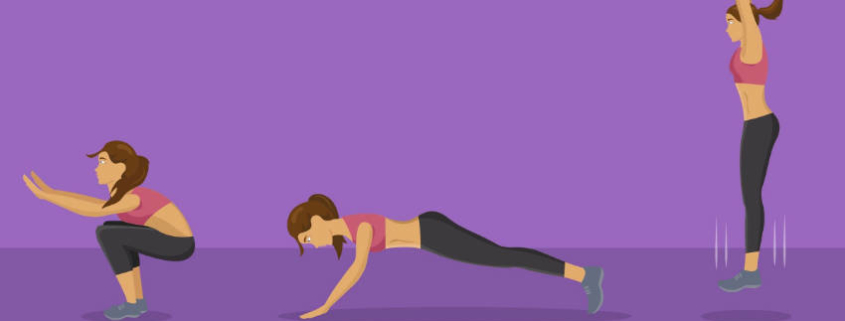Burpees – Balancing the risk vs. reward
“Take care of your body. It’s the only place you have to live.”Jim Rohn
The Burpee is an exercise that was devised by Royal H. Burpee, an American psychologist in the 1930s. It was originally used as a“Burpees test” which consisted of a short number of “Burpees”executed in rapid succession to measure agility, coordination and strength. This test was utilized by the military to assess soldiers who need is to be able to drop into a firing position and then bounce back up lightning-fast to move to a safe position. Today burpees are used completely differently than they were intended. Instead of being a conditioning test – they are the conditioning.
A burpee is essentially a squat that moves quickly to plank position and back all in one movement. Like this: 1. From a standing position, drop down vertically bend over or squat down and place your hands on the floor in front of you, just outside of your feet. 2. In one clean motion, take both feet back, so you are no win a push up position. 3. Drop down to a push-up, until your chest nearly touches the floor. 4. Push up to return to plank position performing a push up. 5. In one clean motion, bring the feet back to between the hands. 6. In one motion, explosively jump into the air, reaching your arms straight overhead.Burpees are not for everyone, they require a pre-requisite level of strength, conditioning and good body mechanics to be used responsibly. If you have poor posture, muscle imbalance, are unfit or carrying extra weight with poor movement patterns, you should only do controlled movement and exercise. Many people perform at least one part of the sequence of movements (comprising a “Burpee”) inappropriately especially if trying to do as many as possible in a short space of time. Chances are that attention to posture will diminish and this could lead to various injuries which may include lower back, knees, shoulders and wrists. If you can’t perform a proper bodyweight squat, hold a plank, do push ups or jump and land properly you should not do the burpee. The burpee serves little purpose and actually a significantly higher risk of injury to the office workers/students and stay-at-home mothers (especially just after pregnancy) who just want to feel fit. Doing any movement or exercise badly may result in injury.
Only in a strong, fit and posturally correct individual, can burpees provide a good bodyweight challenge. In rugby a burpee is sports specific because it is necessary for a rugby player to drop to the ground quickly and/or return to play quickly. Performing a“Burpee,” with weak trunk and hip muscles and stiff upper back and spine may result in undue force on your lower back spinal joints and discs because these muscles that are not adequately conditioned to stabilise such a load and absorb the impacts of this exercise.Dropping too low in the plank position will force your lumbar spine in to extension. When the knees are fully bent just prior to thrusting up from a squat position this can place considerable strain on the cartilage and ligaments of the knees — to the point of vulnerability. It’s the dynamic nature of the burpee that demands quick and powerful bending of the knee and low back done repeatedly (certainly more than eight times) that with each repetition moves further away from benefit and closer to imminent injury.
An osteopath can identify potentially injurious exercises that others may not. Good bio mechanical knowledge allows osteopath to perceive when something, albeit popular, may be hazardous to your spinal and joint health. Muscles tend to adapt and strengthen with exercise, but cartilage, ligaments and tendons tend to become damaged with overuse or improper exercise.
As health professionals, osteopaths are able to advise patients on movement and treat any injuries so the participant can help resume and enjoy a fit and active lifestyle.
View a list of common complains that Osteopathy can assist with
Discovery the benefits of Osteopathy
- What is Osteopathy?
- Adult health issues
- Babies and Children
- During and after pregnancy
- Common Complaints
- Testimonials
- Sports Injuries
- Genral Osteopathy FAQs
- The Science & Reasearch



